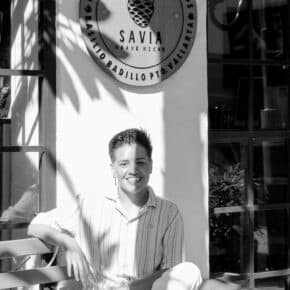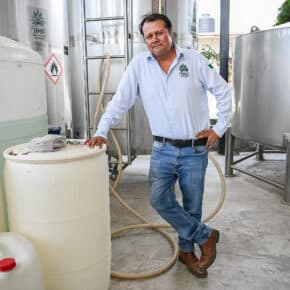The move to virtual programming in the world of alcohol has been pretty impressive ranging from bartending demos and talks on Instagram to virtual happy hours to hosted Zoom talks and of course to our own Zoom series – Conversations in Agave. It is a great time to get your mezcal chops and then some. But how could this translate to doing an actual guided mezcal tasting?
I had a chance to see this in action thanks to the good folks at Las Almas Rotas in the online tasting series they are putting together. While ABC rules are being relaxed around the country, the one thing we haven’t seen is the ability of distributors to sell direct to consumers, so planning a tasting involves organization and time so your audience can get the products they need in order to partake. Of course, you can always do them without the product, as I did for the program last week featuring a Rancho Tepúa Bacanora, a La Higuera Sotol, and a Derrumbes Tamaulipus Mezcal, because the discussion of history and production processes more than made up for any lack of product I could sip on– both Arik Torren, owner of Fidencio Spirits and importer of many mezcal projects, and Esteban Morales, owner of La Venenosa and Derrumbes, were leading the talk called Spirits of the Borderland.
Despite all attempts on my part to try everything in Arik’s portfolio, I definitely have some holes, including for this particular session, having never sampled the mezcal from Tamaulipus, someday, someday!

The tasting went from west to east, meaning we started with the Bacanora from Rancho Tepúa. This was without a doubt the most informative part of the talk for me as I am still getting my Bacanora legs. Max wrote a great piece about the spirit here from his experience at last year’s Agave Heritage Festival in Tucson, Arizona. The name Tepúa is an indigenous word that means ax and is the tool used throughout the process. The master bacanorero at Rancho Tepúa is Roberto Contreras, who was also the producer of Cielo Rojo, the first legal Bacanora imported to the United States.
Arik and Esteban dove deep into Bacanora’s history and that, despite the end of prohibition in Mexico, Bacanora remained illegal for 77 more years in Sonora. Because of that, people used whatever materials they had on hand to continue secretly making the product, using steel drums with copper condensers, which were inexpensive and could be easily disposed of if authorities came around. Piñas were cooked in smaller pit ovens fueled by dead mesquite trees. These ovens were conical in shape and they could be easily unloaded with pitch forks. Then the roasted agaves were chopped up with the namesake tepua axes or with shredders. A tahona was not only expensive, but also so large and permanent that it would tip off the authorities. The Bacanora DO was established in 2006, and like so many other DOs created in Mexican spirits world, used the Tequila DO as a template, which is to say, defining a specific area (Bacanora) and allowing only one kind of agave (Pacifica, a variety within the Angustifolia species) to be used in production.
In addition to the history we dove into the differences between the espadin, also part of the Angustifolia species, and Pacifica, which has a completely different shape, color and size: A Pacifica piña averages about 30kg vs an espadin which is more like 65-70kg. They also talked about the impact climate change has had in the region, including more frequent serious freezes that have killed off crops causing growers to experiment more with how to grow agave. They also hinted at new expressions they were working on, along with news about a new line they will be introducing that won’t be called Bacanora because they will be using other agaves from outside of the Bacanora region. And then folks tasted the product and commented on its refreshing and floral flavor notes that were light on the palette.
Next up was the La Higuera Sotol Cedrosanum made by Gerardo Ruelas in Chihuahua. La Higuera was one of the first Sotols in the market, launching in Europe first in 2016 and then in the United States. The conceit of the project is very different from other Sotols in the market: The focus is on using different varieties from across the region, but making it all at the same production facility, so that the only variation among expressions is the plant itself. Everything else is controlled by working with the same maker, water source, oven, fermentation, and still. There are endless possibilities given there are almost 21 varieties within the Dasylirion species.
Ruelas roasts the piñas in pit ovens then crushes them first by hand and then a shredder. It is an open fermentation set up, using the mosto, before going into 800 liter copper pots. A question came up about how the plants are harvested. Unlike with agave, the Dasylirion can be harvested in a way that keeps the roots intact so that it can regrow. However, Ruelas has found that the second growth tends to have a more bitter flavor than the original plant so he doesn’t generally follow this method and instead replants with seed. As for the flavor profile, people remarked on the smoked grassiness and dry finish.
The final taste was the Derrumbes Tamaulipus from Maestro Mezcalero Cuauthemóc Jacquez. The Derrumbes brand is an exploration of the various mezcal producing regions in Mexico and reflects the unique traditions and techniques of each location. Don Jacquez creates an ensemble that includes Americana, Univatta, and Funkiana agaves. The bottle for this tasting was a special batch that also included an Agave Montana. The backbone of his ensemble is the Americana, a species which includes Arroqueño, Coyote, and Cenizo which provides much of the sugar. The agaves are all roasted underground with black oak, crushed with a shredder, fermented in stainless steel tanks, and distilled together to create a mezcal that can range from 46-52% ABV.
Like many a tasting, as you move through the different tastes, it becomes less about the actual flavor and more about the story and questions that come up. I am not sure we even touched upon the actual flavor notes because Esteban began talking about the realities of travel to Tamaulipas, an area the has been a hotbed of narco activity and unrest for years; so much so that Esteban had not even visited the palenque before deciding to working with Don Jacquez.
They also talked about the impact thus far of Coronavirus on mezcal production. Currently there hasn’t been much impact on the brands because they have stocks being sold in the US. But since March and April are the traditional production period, it’s unclear to everyone whether there will be more stocks of these spirits for future shipments. We are hearing from other people that the slowdown in sales in the US means that producers in Mexico are sitting on product so it’s perfectly possible that things will spring back into action as personal and business restrictions are loosened. Right now it’s too hard to tell.
This was all incredibly fun and edifying. If I can’t get to Mexico for my research trips and can’t get out to talk to people at tastings, at least we can join together virtually. But the biggest hurdle is how to get product to participants. It’s almost like the last mile issue broadband internet access once had. If we can figure that out, this is an easily replicable and cost effective way to do educational programming. While that social interaction is obviously not the same in a virtual world, the ability to ask questions, meander through topics, read the crowd, and shift direction as needed is all there. And recording the actual tasting notes becomes less important as by the biggest question of all, would I drink more of this?













Leave a Comment